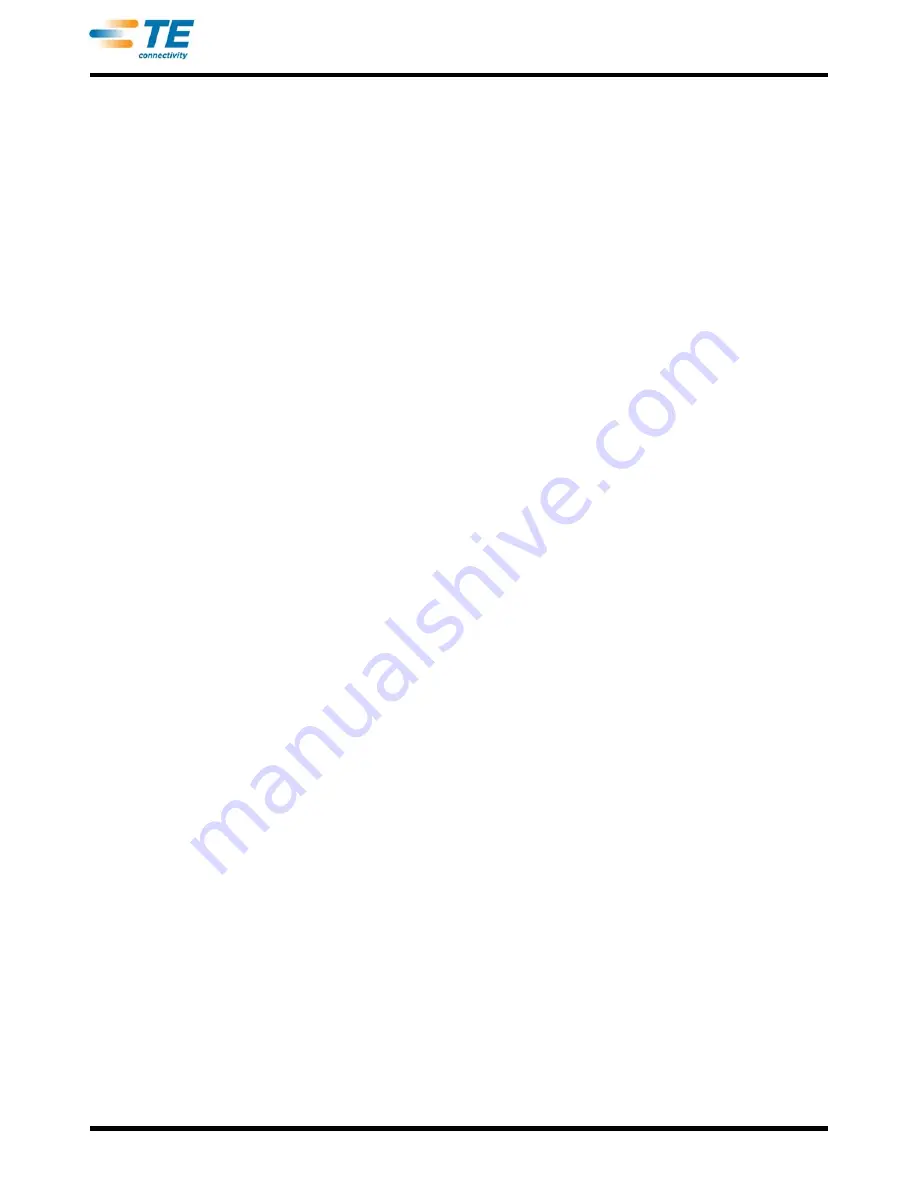
408-1809
3 of 5
Rev B
4. INSULATION CRIMP ADJUSTMENT
The insulation barrel crimp height is regulated by
placing the insulation crimp adjustment pins in one of
three positions: (1) small, (2) medium, or (3) large.
Determine the proper insulation crimp setting as
follows:
1. Place adjustment pins in No. 3 position. Insert
terminal into tool according to Section 3, CRIMPING
PROCEDURE, Steps 1 through 4.
2. Insert an UNSTRIPPED wire into terminal
insulation barrel. Crimp terminal and remove from
tool.
3. Check insulation crimp by bending wire back and
forth one time. If wire pulls out, place adjustment
pins in next smaller position and repeat these
procedures. Crimp should hold wire insulation firmly
without cutting into it.
5. MAINTENANCE AND INSPECTION PROCEDURE
The company recommends that a maintenance and
inspection program be performed periodically to
ensure dependable and uniform terminations.
Frequency of inspection depends on:
•
The care, amount of use, and handling of the hand
tool.
•
Abnormal amounts of dust and dirt.
•
The degree of operator skill.
•
Your own established standards.
The hand tool is inspected before being shipped;
however, TE recommends that the tool be inspected
immediately upon arrival to ensure that the tool has
not been damaged during shipment. Due to the
precision design, it is important that no parts of these
tools be interchanged except those replacement parts
listed in Figure 5.
5.1. Daily Maintenance
1. The hand tools should be immersed (handles
partially closed) in a reliable commercial degreasing
compound to remove accumulated dirt, grease, and
foreign matter. When degreasing compound is not
available, tool may be wiped clean with a soft, lint-
free cloth. Do NOT use hard or abrasive objects that
could damage the tool.
2. Make certain that the retaining pins are in place
and that they are secured with retaining rings.
3. All pins, pivot points, and bearing surfaces should
be protected with a THIN coat of any good SAE† 20
motor oil. Do not oil excessively.
° SAE is the Society of Automotive Enginners.
4. When the tool is not in use, keep handles closed
to prevent objects from becoming lodged in the
crimping jaws. Store the tool in a clean, dry area.
5.2. Periodic Inspection
A. Lubrication
Lubricate all pins, pivot points, and bearing surfaces
with SAE 20 motor oil as follows:
— Tools used in daily production - lubricate daily
— Tools used daily (occasional) - lubricate weekly
— Tools used weekly - lubricate monthly
Wipe excess oil from tool, particularly from crimping
area. Oil transferred from the crimping area onto
certain terminations may affect the electrical
characteristics of an application.
B. Visual Inspection
1. Close tool handles until ratchet releases and then
allow them to open freely. If they do not open
quickly and fully, the spring is defective and must be
replaced. See Section 6, REPLACEMENT AND
REPAIR.
2. Inspect head assembly for worn, cracked, or
broken jaws. If damage is evident, return the tool to
AMP for evaluation and repair. See Section 6,
REPLACEMENT AND REPAIR.
C. Gaging The Crimping Chamber
This inspection requires the use of a plug gage
conforming to the dimensions provided in Figure 4. TE
does not manufacture or market these gages. To gage
the crimping chamber, proceed as follows:
1. Remove traces of oil or dirt from the crimping
chambers and plug gage.
2. Close tool handles until jaws are bottomed, and
hold in this position. Do not force beyond initial
contact.
3. Carefully insert GO element into the crimping
chamber; do not force it. The GO element must
pass completely through the crimping chamber. See
Figure 4.
4. In the same manner, try to insert NO-GO element
into the same crimping chamber. The NO-GO
element may begin entry, but may not pass through
the crimping chamber. See Figure 4.
If crimping chambers conform to gage inspection, the
tool is considered dimensionally correct, and should
be lubricated with a THIN coat of any good SAE 20
motor oil. If not, refer to Section 6, REPLACEMENT
AND REPAIR for customer repair service.























